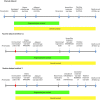Estimating progression-free survival in patients with glioblastoma using routinely collected data
- PMID: 28956223
- PMCID: PMC5700233
- DOI: 10.1007/s11060-017-2619-1
Estimating progression-free survival in patients with glioblastoma using routinely collected data
Abstract
Glioblastoma (GBM) represents 80% of all primary malignant brain tumours in adults. Prognosis is poor, and there is a clear correlation between disease progression and deterioration in functional status. In this pilot study we assess whether we can estimate disease progression and progression free survival (PFS) from routinely collected electronic healthcare data. We identified fifty patients with glioblastoma who had chemo-radiotherapy. For each patient we manually collected a reference data set recording demographics, surgery, radiotherapy, chemotherapy, follow-up and death. We also obtained an electronic routine data set for each patient by combining local data on chemotherapy/radiotherapy and hospital admissions. We calculated overall survival (OS) and PFS using the reference data set, and estimated them using the routine data sets using two different methods, and compared the estimated measures with the reference measures. Overall survival was 68% at 1 year and median OS was 12.8 months. The routine data correctly identified progressive disease in 37 of 40 patients and stable disease in 7 of 10 patients. PFS was 7.4 months and the estimated PFS using routine data was 9.1 and 7.8 months with methods 1 and 2 respectively. There was acceptable agreement between reference and routine data in 49 of 50 patients for OS and 35 of 50 patients for PFS. The event of progression, subsequent treatment and OS are well estimated using our approach, but PFS estimation is less accurate. Our approach could refine our understanding of the disease course and allow us to report PFS, OS and treatment nationally.
Keywords: Glioblastoma; Overall survival; Progression free survival; Routine data.
Conflict of interest statement
All authors declare no conflict of interest.
Figures
References
-
- CBTRUS. Statistical report: primary brain tumors in the United States, 1998–2002. Central Brain Tumor Registry of the United States
-
- Velentgas P, Dreyer NA, Nourjah P, Smith SR, Torchia MM (2013) Developing a protocol for observational comparative effectiveness research: a user’s guide. AHRQ Publication No. 12(13)-EHC099. Agency for Healthcare Research and Quality, Rockville. http://www.effectivehealthcare.ahrq.gov/ Methods-OCER.cfm - PubMed
MeSH terms
LinkOut - more resources
Full Text Sources
Other Literature Sources
Medical




